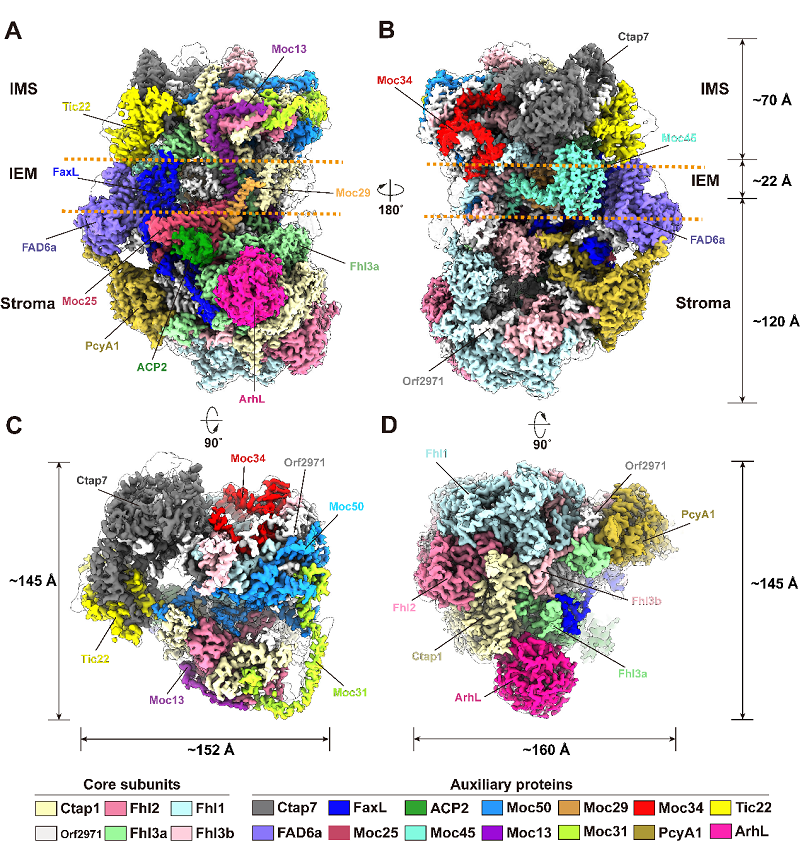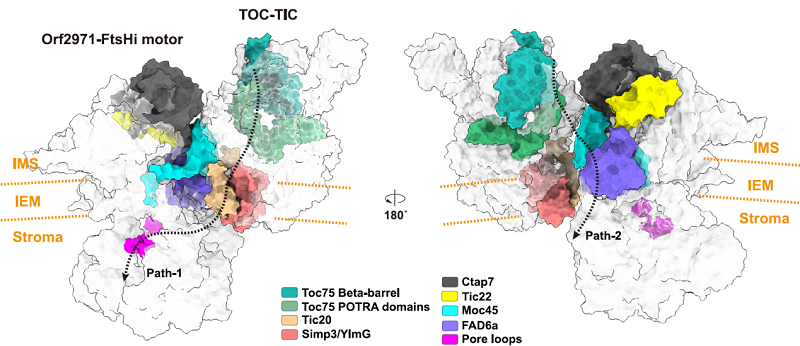Scientists reveal the structural basis for the precursor protein import into chloroplasts
Chloroplasts are crucial organelles in plant cells responsible for photosynthesis. Most of the chloroplast proteins are encoded by nuclear genome, and synthesized in the cytoplasm. The transport of these precursor proteins into chloroplasts is highly dependent on complex and sophisticated translocation systems known as translocons. The TOC-TIC complex, which is composed of the TOC complex (Translocon at the outer envelope of chloroplasts) and TIC complex (Translocon at the inner envelope of chloroplasts) located on the outer and inner envelope membranes of the chloroplast, is responsible for the transport of most precursor proteins from the cytoplasm to the chloroplast. Previous researches have revealed the protein composition and the transport pathways of the TOC-TIC complex; however, how this protein translocation system utilizes ATP molecules to achieve the transmembrane transport of precursor proteins remain unclear. Several earlier studies have suggested that the protein transport system contains a 2-MD complex, referred to as the motor complex, that plays a key role in driving the transport process. However, little is known about the protein composition and the architecture of the motor complex, as well as the details of the precursor protein translocation.
On November 7, 2024, the research team led by LI Mei in the Institute of Biophysics, Chinese Academy of Sciences (IBP, CAS), and YANG Wenqiang in the Institute of Botany, Chinese Academy of Sciences (IB, CAS), published a research paper entitled "Architecture of the ATP-driven motor for protein import into chloroplasts" in Molecular Plant.

Figure 1. The overall structure of the Orf2971-FtsHi motor complex
A-B, Side views of Orf2971-FtsHi motor complex along the inner envelope membrane (IEM, represented by the orange dotted lines). The protein subunits are painted in different colors. IMS, intermembrane space. C, Top view of Orf2971-FtsHi motor complex from the side of the intermembrane space. D, Bottom view of the Orf2971 motor complex from the stromal side.
This study elucidated the high-resolution structure of the Orf2971-FtsHi complex (Figure 1), a chloroplast motor complex from Chlamydomonas reinhardtii, revealing the protein composition and assembly details of the complex, and suggesting the transport pathways of precursor proteins. The Orf2971-FtsHi complex is a 20-subunit complex composed of 19 unique proteins, spanning the inner envelope membrane of the chloroplast and protruding into the chloroplast intermembrane space and the stromal matrix. Orf2971 is a protein encoded by the chloroplast genome with a total molecular weight of approximately 341 kDa, and was suggested to have originated from the FtsH protease. This protein serves as a scaffold within the complex, directly interacting with 17 of the other 19 protein subunits, thus playing a crucial role in the assembly and stability of the entire complex. In addition, four proteins in the complex, namely Ctap1, Fhl1, Fhl2, and Fhl3, also originated from the FtsH protease. Structural analysis revealed that these five FtsH-like proteins together form a heterohexameric core (one copy each of Orf2971, Ctap1, Fhl1 and Fhl2, and two copies of Fhl3), that shapes like a double-layer disc and provides the pulling force necessary for the transmembrane transport of precursor proteins through ATP hydrolysis. The remaining 14 protein subunits assist in the assembly and stabilization of the complex, and may also participate in the transport of precursor proteins and the regulation process. Furthermore, this study demonstrates that the Tic22 protein in the motor complex directly interacts with the Toc75 protein in the TOC-TIC complex, through surface plasmon resonance (SPR) technology and Gaussian accelerated molecular dynamics simulations, thus proposing a potential model of the TOC-TIC complex interacting with the motor complex (Figure 2). This study provides important information for the coordination between the two complexes, and structural basis for understanding the process of the transport of precursor proteins.

Figure 2. The possible interaction mode between TOC-TIC and Orf2971-FtsHi motor
Article link: https://doi.org/10.1016/j.molp.2024.09.010
Contact: LI Mei
Institute of Biophysics, Chinese Academy of Sciences
Beijing 100101, China
Email: meili@ibp.ac.cn
(Reported by Prof. LI Mei'group)

